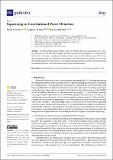| dc.contributor.author | Dwyer, Sheila E. | |
| dc.contributor.author | Mansell, Georgia L. | |
| dc.contributor.author | McCuller, Lee | |
| dc.date.accessioned | 2022-03-10T16:40:42Z | |
| dc.date.available | 2022-03-10T16:40:42Z | |
| dc.date.issued | 2022-03-09 | |
| dc.identifier.uri | https://hdl.handle.net/1721.1/141122 | |
| dc.description.abstract | Injecting optical squeezed states of light, a technique known as squeezing, is now a tool for gravitational wave detection. Its ability to reduce quantum noise is helping to reveal more gravitational wave transients, expanding the catalog of observations in the last observing run. This review introduces squeezing and its history in the context of gravitational-wave detectors. It overviews the benefits, limitations and methods of incorporating squeezing into advanced interferometers, emphasizing the most relevant details for astrophysics instrumentation. | en_US |
| dc.publisher | Multidisciplinary Digital Publishing Institute | en_US |
| dc.relation.isversionof | http://dx.doi.org/10.3390/galaxies10020046 | en_US |
| dc.rights | Creative Commons Attribution | en_US |
| dc.rights.uri | https://creativecommons.org/licenses/by/4.0/ | en_US |
| dc.source | Multidisciplinary Digital Publishing Institute | en_US |
| dc.title | Squeezing in Gravitational Wave Detectors | en_US |
| dc.type | Article | en_US |
| dc.identifier.citation | Galaxies 10 (2): 46 (2022) | en_US |
| dc.contributor.department | LIGO (Observatory : Massachusetts Institute of Technology) | |
| dc.relation.journal | Galaxies | en_US |
| dc.identifier.mitlicense | PUBLISHER_CC | |
| dc.eprint.version | Final published version | en_US |
| dc.type.uri | http://purl.org/eprint/type/JournalArticle | en_US |
| eprint.status | http://purl.org/eprint/status/PeerReviewed | en_US |
| dc.date.updated | 2022-03-10T14:19:12Z | |
| dspace.date.submission | 2022-03-10T14:19:12Z | |
| mit.license | PUBLISHER_CC | |
| mit.metadata.status | Authority Work and Publication Information Needed | en_US |
